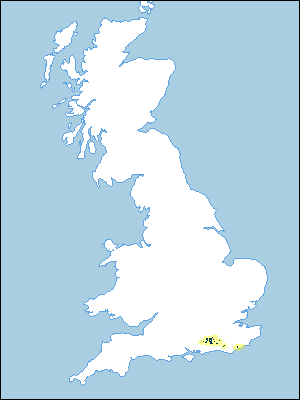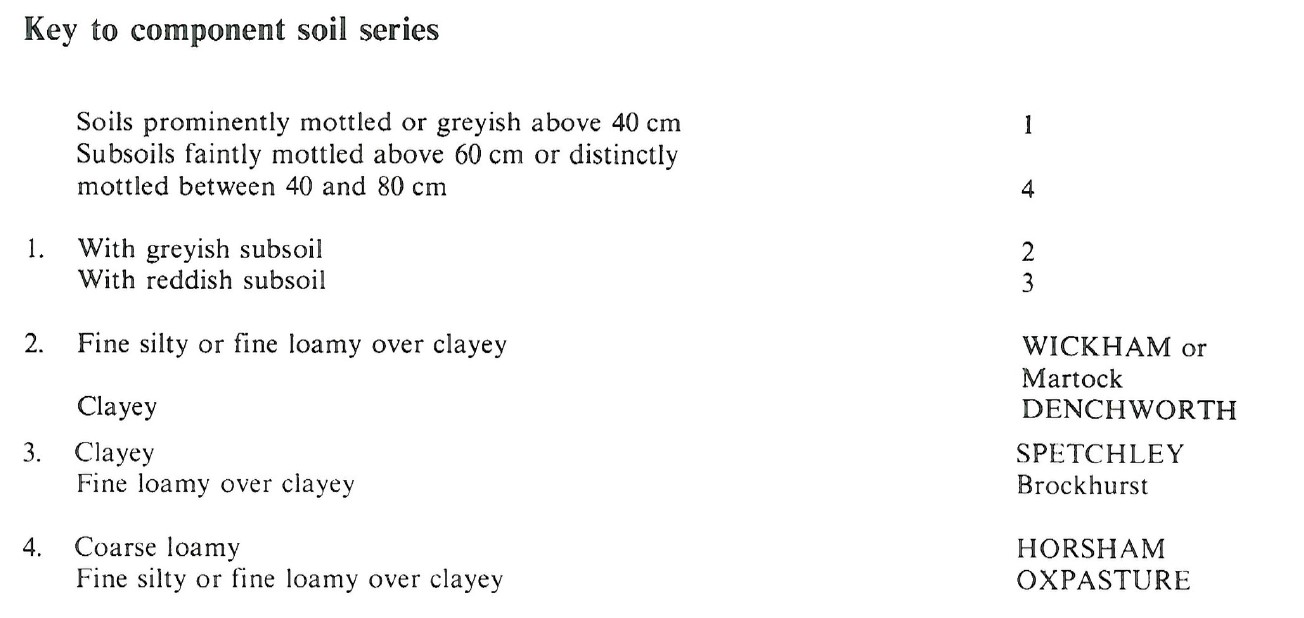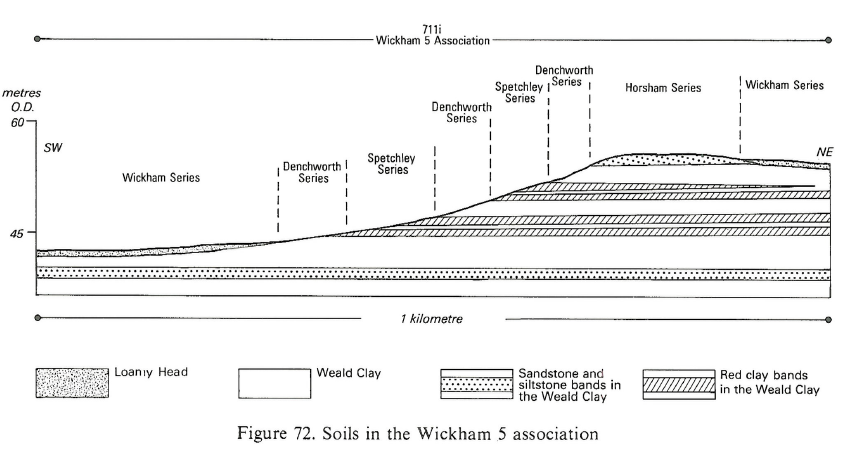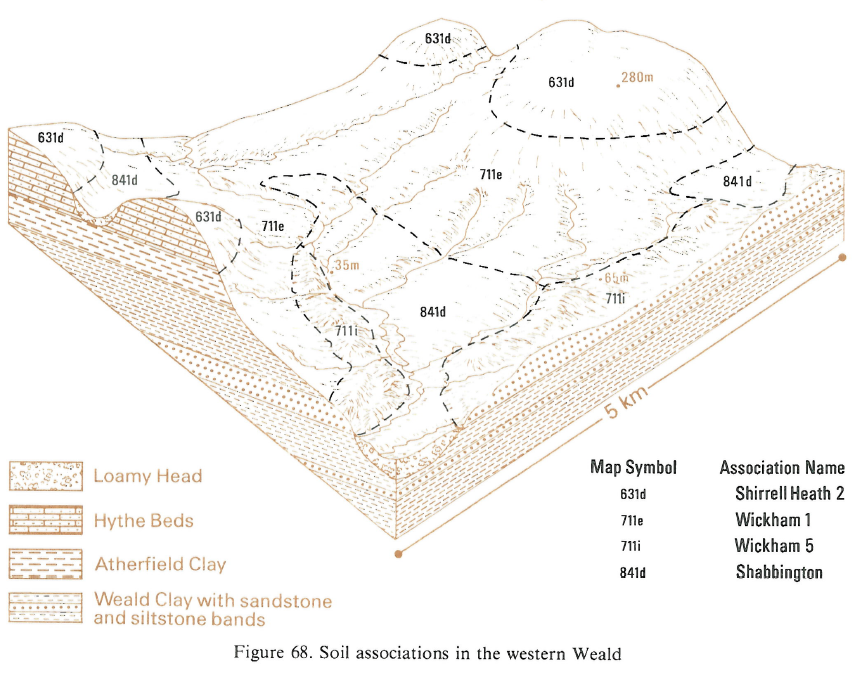
Soil Associations
0711i WICKHAM 5
Soil and site characteristics
Slowly permeable seasonally waterlogged fine loamy over clayey, fine silty over clayey and clayey soils locally reddish. Some coarse loamy soils with slowly permeable subsoils and slight seasonal waterlogging over sandstone.
Geology
Drift over Cretaceous clay and sandstone
Cropping and Land Use
Dairying on short term grassland. some cereals; some fruit in West Sussex; deciduous woodland.
Component soil series
| Subgroup | Series name | Percentage | WRB 2006 link |
|---|---|---|---|
| 7.11 | WICKHAM | 35% | Eutric Luvic Planosols |
| 7.12 | DENCHWORTH | 12% | Eutric Vertic Stagnosols |
| 7.12 | SPETCHLEY | 10% | Clayic Chromic Eutric Stagnosols |
| 5.42 | HORSHAM | 10% | Eutric Endostagnic Cambisols |
| 5.72 | OXPASTURE | 10% | Endostagnic Luvisols |
Covers 234 km2 in England and Wales
Soilscapes Classification
| 18 |
Slowly permeable seasonally wet slightly acid but base-rich loamy and clayey soils |
0711i WICKHAM 5
Detailed Description
Seasonally waterlogged surface-water gley soils over clay are accompanied in this association by drier medium- and coarse-textured soils over sandstone and fine-textured reddish soils. The soils occur in the western part of the Low Weald and are extensive between Crawley in West Sussex and Rake in east Hampshire. There are smaller areas north of Lewes and Hastings, the latter on the southern flank of the High Weald. The soils are developed in thin drift over Cretaceous clays and sandstones. In West Sussex, where the soils are over the Weald Clay, there are many associated thin siltstones and hard sandstones, for example, the Horsham Stone, as well as reddish haematitic clayey beds. Thin sandstones and siltstones are also present where the association is mapped on Wadhurst Clay north of Hastings, but red beds are less common here. Thin superficial loamy and silty Head is ubiquitous and is mainly derived from Wealden strata but locally includes aeolian silty drift. The landscape is well wooded and rounded hills and ridges often capped by sandstones are separated by broad valleys.
The fine loamy and fine silty over clayey Wickham series, typical stagnogley soils, usually cover about one-third of the land and are widely distributed on gentle slopes. Clayey Denchworth series, pelo-stagnogleys soils, are also common on similar sites where the drift is thinner. Moderately deep Horsham soils, stagnogleyic brown earths, are found on hill and ridge tops, but also as narrow bands on slopes alternating with bands of reddish, clayey Spetchley soils, pelo-stagnogleys soils. Oxpasture soils, stagnogleyic argillic brown earths, are particularly common over clays associated with the Horsham Stone and over the Wadhurst Clay interbedded with sandstone; they are rare over Weald Clay.
Other soils occur locally on siltstones, sandstones and reddish beds. Martock soils passing to siltstone or shale, are the commonest, particularly around Horsham and Hastings; but similar soils with red subsoils are found in some places. Silty Cranbrook and Curtisden soils are common in all districts, locally associated with similar reddish Middleton soils. Reddish Spetchley soils are most extensive west of Horsham where they cover up to one-fifth of the ground. Other red soils include seasonally waterlogged fine silty over clayey Brockhurst series, and coarse loamy over clayey Hindlip series . Well drained sandy Shedfield and Frilford soils over sandstone are developed in patches on some hilltops. Small areas of Waterstock soils on river terraces are included in most districts. Some Kingston soils are present to the north of Lewes.
Soil Water Regime
Vertical drainage is slow in most soils either because of slowly permeable clayey subsoils or because they rest on compact siltstones and sandstones. Wickham, Denchworth and Spetchley series with clayey subsoils are waterlogged for long periods in winter (Wetness Class IV), but with suitable drainage measures the duration of waterlogging can be reduced. Horsham and Oxpasture series, with deep clayey or sandstone or siltstone subsoils, are waterlogged for shorter periods (Wetness Class II or III). Excess winter rain runs off rapidly. The principal soils have good reserves of available water and cereals suffer only slightly from drought in most years but grass production is seriously reduced.
Cropping and Land Use
Wickham soils are difficult to cultivate and Denchworth and Spetchley soils often intractable. In most seasons there are only short periods in autumn and a very few days in spring when field conditions on Wickham, Denchworth and Spetchley soils are suitable for cultivating without risk of damage, and so early autumn cultivation is essential. Oxpasture soils are less difficult to cultivate and there are more days available for safe autumn ploughing but timeliness is essential. Opportunities for cultivating Horsham soils are more frequent but soil structure is usually weak and upper layers can easily be compacted: fine seedbeds are liable to slake and cap after heavy rain.
Most farms are mixed arable and dairy enterprises. Wheat, grass and other fodder crops are grown in rotation and there is usually some permanent grass on each holding. Large yields of cereals and oilseed rape are possible with good management and cultivation practice. Grassland production is restricted by drought and there is a serious risk of poaching in winter. Land with extensive Horsham and Oxpasture soils is more flexible and potatoes and field vegetables are grown successfully; irrigation is beneficial in most years. Top and soft fruit are grown near Kirdford in West Sussex; orchards are drained by closely-spaced pipes and the water collected in reservoirs to be used for irrigation in summer. All of the soils need regular liming. Phosphorus fertilizer is required where woodland is cleared for agriculture.
Trees grown in Wickham, Denchworth and Spetchley soils need to be tolerant of prolonged winter waterlogging. Shallow rooting causes poor growth and windthrow on more exposed sites. Corsican and Scots pines, Norway spruce, western hemlock and western red cedar are the best suited species. The less-waterlogged Horsham and Oxpasture soils are most productive, although siltstone and sandstone bands in Horsham soils can restrict rooting. Larch, oak, red oak, beech and sweet chestnut are also grown on these soils. Crops on Horsham soils benefit from both nitrogen and phosphorus applications which encourage deep rooting and good establishment. Weed competition is often severe and tine ploughing helps to suppress weeds and assists with surface drainage by loosening compact subsoils. Many small, mature oak and mixed woodlands and overgrown hazel and chestnut coppices remain from the once extensive woodland cover.
0711i WICKHAM 5
Distribution Map
 |
Note that the yellow shading represents a buffer to highlight the location of very small areas of the association.
Keys to component soil series
South Eastern Region
 |
Typical Landscapes
South Eastern Region
 |
South Eastern Region
 |
All information Copyright, Cranfield University © 2025
Citation: To use information from this web resource in your work, please cite this as follows:
Cranfield University 2025. The Soils Guide. Available: www.landis.org.uk. Cranfield University, UK. Last accessed 25/04/2025
